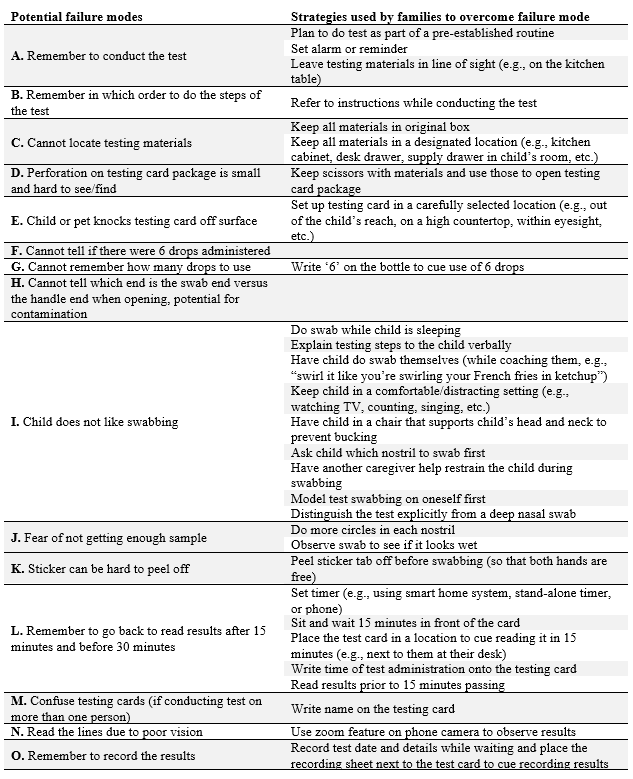Health Services Research
Category: Abstract Submission
Health Services Research III
14 - Task analysis of in-home SARS-CoV-2 rapid antigen testing by families caring for children with medical complexity
Monday, April 25, 2022
3:30 PM - 6:00 PM US MT
Poster Number: 14
Publication Number: 14.414
Publication Number: 14.414
Hanna J. Barton, University of Wisconsin - Madison, Madison, WI, United States; NICOLE WERNER, University of Wisconsin-Madison, MADISON, WI, United States; Makenzie B. Morgen, University of Wisconsin School of Medicine and Public Health, Madison, WI, United States; Gregory DeMuri, Univ of Wisconsin School of Medicine and Public Health, Madison, WI, United States; Michelle M. Kelly, University of Wisconsin School of Medicine and Public Health, Madison, WI, United States; Ellen R. Wald, University of Wisconsin School of Medicine and Public Health, Madison, WI, United States; Ryan J. Coller, University of Wisconsin School of Medicine and Public Health, Madison, WI, United States

Hanna J. Barton, MS
Research Assistant
University of Wisconsin - Madison
University of Wisconsin - Madison
Madison, Wisconsin, United States
Presenting Author(s)
Background: Ideal SARS-CoV-2 testing platforms are simple, accessible, and rapid enough to facilitate action to prevent the spread of COVID-19. In-home rapid antigen SARS-CoV-2 testing offers promising benefits, but our poor understanding of real-world barriers limits our ability to trust results collected by lei people.
Objective: Our objective was to apply hierarchical task analysis (HTA) to 1) model the task of in-home rapid antigen testing by parents; 2) identify potential failure modes associated with in-home testing; 3) identify and categorize strategies families use to address potential failure modes.
Design/Methods: Participants already enrolled in a larger study aimed at increasing safe return to school were invited to demonstrate how they conduct the test on their child in a virtual meeting with researchers. Sessions were recorded and transcribed. Through team-based content analysis, a hierarchical task analysis (HTA) was iteratively developed.
Results: We enrolled 20 caregivers in July 2021. The majority identified as women (90%), white (80%), average age of 40 years-old (Range = 32-59).
HTA revealed that in-home testing required 14 primary steps (e.g., 1.1), 10 of which required sub-tasks for a total of 44 steps to achieve 3 sub-goals (e.g., 1) (Figure 1). Fifteen potential failure modes (e.g., A) were identified, which were addressed with 29 strategies (Table 1).Conclusion(s): Our results highlight vulnerable steps in in-home SARS-CoV-2 testing procedures that might influence test reliability or validity. These failure modes may help explain previously observed sensitivity discrepancies of rapid antigen tests between healthcare and non-healthcare professionals; and the strategies can inform future test design.
Interpreting in-home test results is challenging and our findings uncover vulnerable areas that could be useful to clinicians. For example, when speaking with patients, clinicians may probe about failure modes to ensure proper testing procedures. Knowing how to evaluate high quality test procedures will bolster confidence among those depending on reliable results, e.g., clinicians, employers, school administrators, etc.
The many steps, potential failure modes, and strategies involved with in-home rapid antigen SARS-CoV-2 testing by families may influence test performance. Given the expected rise of direct-to-consumer test availability, similar studies will help optimize the accuracy of conclusions drawn from in-home diagnostic tests.
HannaBarton_CV(2).pdf
Table 1 Potential failure modes with associated strategies used by families to overcome them.
Potential failure modes with associated strategies used by families to overcome them.
Objective: Our objective was to apply hierarchical task analysis (HTA) to 1) model the task of in-home rapid antigen testing by parents; 2) identify potential failure modes associated with in-home testing; 3) identify and categorize strategies families use to address potential failure modes.
Design/Methods: Participants already enrolled in a larger study aimed at increasing safe return to school were invited to demonstrate how they conduct the test on their child in a virtual meeting with researchers. Sessions were recorded and transcribed. Through team-based content analysis, a hierarchical task analysis (HTA) was iteratively developed.
Results: We enrolled 20 caregivers in July 2021. The majority identified as women (90%), white (80%), average age of 40 years-old (Range = 32-59).
HTA revealed that in-home testing required 14 primary steps (e.g., 1.1), 10 of which required sub-tasks for a total of 44 steps to achieve 3 sub-goals (e.g., 1) (Figure 1). Fifteen potential failure modes (e.g., A) were identified, which were addressed with 29 strategies (Table 1).Conclusion(s): Our results highlight vulnerable steps in in-home SARS-CoV-2 testing procedures that might influence test reliability or validity. These failure modes may help explain previously observed sensitivity discrepancies of rapid antigen tests between healthcare and non-healthcare professionals; and the strategies can inform future test design.
Interpreting in-home test results is challenging and our findings uncover vulnerable areas that could be useful to clinicians. For example, when speaking with patients, clinicians may probe about failure modes to ensure proper testing procedures. Knowing how to evaluate high quality test procedures will bolster confidence among those depending on reliable results, e.g., clinicians, employers, school administrators, etc.
The many steps, potential failure modes, and strategies involved with in-home rapid antigen SARS-CoV-2 testing by families may influence test performance. Given the expected rise of direct-to-consumer test availability, similar studies will help optimize the accuracy of conclusions drawn from in-home diagnostic tests.
HannaBarton_CV(2).pdf
Table 1
 Potential failure modes with associated strategies used by families to overcome them.
Potential failure modes with associated strategies used by families to overcome them.